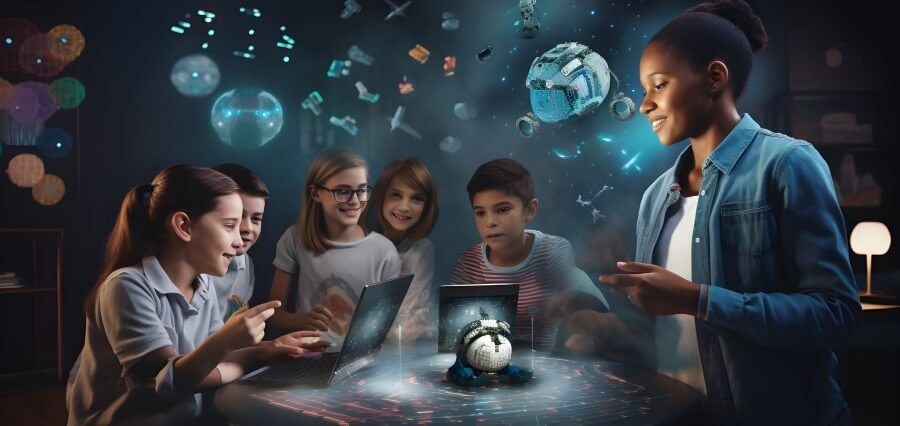Technology in the process of learning has revolutionized the face of learning, and the classroom today is more interactive and vibrant. Technology’s impact is felt throughout the curriculum and to motivation among students. This article explores some of the ways technology is impacting the education sector.
Understanding the Impact of Technology in Education
- Increased Student Participation and Motivation
Technology offers several alternatives that are available to be used in order to involve students and interactivity the learning process. Interactive whiteboards, learning apps, and game-based learning solutions offer new experiences that lead to involved students who are interested in the learning process. Increased involvement is the immediate consequence of the effect of technology on learning.
- Personalizing Learning Experiences
One of the most significant strengths of technology is that learning can be personalized. Adaptive learning programs and individualized learning paths are employed in conjunction with students’ own learning rate and learning preference. Personalized learning ensures that every student receives the support that they need to be successful. Personalization is among the greatest things about the technology in teaching. 3. Greater access to instructional material:
Technology has geographically aligned people and made learning content available. Virtual classrooms, e-libraries, and web courses have placed the learning content and information world at the door of the learner wherever he or she is and irrespective of their socioeconomic status. This is a revolutionary facet of technology application in learning.
- Facilitating Collaborative Learning
Collaborative learning resources such as group documents, videoconferencing, and online discussions enable students to collaborate on assignments and projects anywhere. This offers a chance to communicate, collaborate, and build community. Greater collaboration is an obvious demonstration of the impact of technology on learning.
- Building 21st-Century Skills:
The modern workforce requires skills such as digital competency, problem-solving, and critical thinking. Incorporation of technology into the learning process enriches learning for such skills through experience in digital tool utilization, problem-solving, and data analysis. Skills development is one of the greatest contributions of technology to learning.
- Increasing Teacher Efficiency and Productivity
Technologgy facilitates day-to-day activities like grading, attendance, lesson planning by enabling the teachers to free up time spent in teaching and guiding the students.
Learning management system and e-learning technologies are capable of executing such day-to-day activity in a more efficient manner with enhanced productivity from additional teachers.
Gained efficiencies become an education power that acts in favor of relaxing education in a beneficial manner.
- Supporting Remote and Blended Learning
The COVID-19 pandemic accelerated the adoption of online and blended learning models. Technology provides the platforms and tools for successful online learning with a promise of continuity of learning amidst disruption. The best aspect of using technology in education is flexibility.
- Providing Data-Driven Insights
Learning analytics platforms provide data-driven feedback to educators and administrators about student achievement, learning activity, and engagement.19 Instructional direction is delivered in the guise of data, the trouble spots are revealed, and interventions are tweaked. Good decision making is an easy side effect of technology’s involvement in education.
- Increasing Accessibility for Disabled Students
Technology offers a variety of assistive tools and capabilities sensitive to the requirements of students’ disabilities. Screen-reader, text-to-speech, and adaptive learning software bundles offer tailored assistance, hence equating all the students on an equal basis as active learners. Accessibility is a theme inherent in the utilization of technology for education.
- Facilitating Global Connectivity
Technology enables global connection, where students can communicate with other students and experts from around the world. This broadens their vista, introduces them to other perspectives, and creates cross-cultural consciousness.
- Promoting Lifelong Learning
Technology promotes lifelong learning through e-learning modules, webinars, and software programs. This enables one to keep learning and improving themselves each day as they are able to cope with the changing demands of the 21st century.
- Digital Citizenship:
Technology-based learning enables the acquisition of digital citizenship skills such as internet safety, internet ethics, and online behavior to suit the environment.
- Encouraging Imagination and Ingenuity:
Technology and the internet allow learners to exercise their imagination and create innovative solutions such as the application of digital design technology, multimedia presentation design, and discovery of new technology.
- Ready Labor for the Future:
Technology-enhanced learning allows for the production of future labor to support the necessary work in terms of the age of digital technology.
The future employment market will be largely reliant on technology. Technology integration into learning ensures learners possess the skills and knowledge needed to thrive in a technologically driven world.
With the discovery and adoption of the powerful potential of technology, teachers are able to produce more interactive, personalized, and accessible education for everyone. Continuous development in technology has the capacity to make the learning environment even better, revealing the destiny of learners worldwide.





